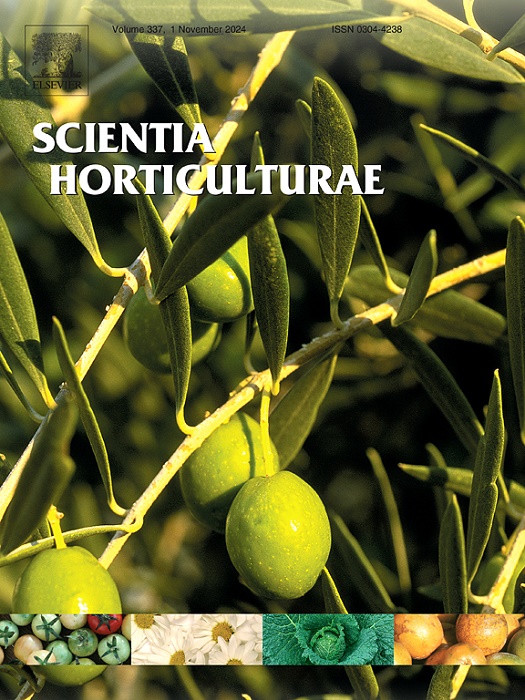生长素通过影响水仙的碳水化合物代谢调节球茎发育
IF 3.9
2区 农林科学
Q1 HORTICULTURE
引用次数: 0
摘要
百合球茎起源于百合中上部茎的叶腋,在三倍体百合的繁殖中起着重要的作用。百合球茎的发育过程是细胞分裂和扩增的结果,但植物激素和碳水化合物代谢在其中的作用尚不清楚。本研究以外源吲哚-3-乙酸(IAA)和生长素极性运输抑制剂n -1-萘酞酸(NPA)处理水仙,分析了水仙鳞茎发育过程中的形态、转录组学和基因功能。IAA处理增加了鳞茎直径和单株总重,促进了鳞茎发育。通过构建性状与模块的关联网络,我们发现球茎直径与与植物激素和碳水化合物代谢相关的黑色模块基因呈显著负相关,与黄色模块基因呈显著正相关。由于球根和球根发育相似,我们确定了球根系统中的关键基因。沉默生长素信号通路中的LlSAUR36和LlIAA10基因可抑制小球的发育。在碳水化合物代谢途径中,我们使用沉默方法鉴定了两个关键基因LlTPS1和LlCSLC5,导致表型类似于LlSAUR36和LlIAA10,它们抑制球茎发育。综上所述,生长素信号通路通过调控关键的碳水化合物代谢基因参与了水仙球茎的发育。该研究为百合球茎的开发提供了分子基础,并为百合球茎生产新方法的开发提供了有益的线索。本文章由计算机程序翻译,如有差异,请以英文原文为准。
Auxin regulates bulbil development by affecting carbohydrate metabolism in Lilium lancifolium
Lily bulbils originate from the leaf axils of the middle and upper stems of lilies and play an important role in the reproduction of triploid Lilium lancifolium. The development process of lily bulbils results from cell division and expansion, but the roles of plant hormones and carbohydrate metabolism remains unclear. In this study, we treated L. lancifolium with exogenous indole-3-acetic acid (IAA) and the auxin polar transport inhibitor N-1-naphthylphthalamic acid (NPA) and analyzed morphology, transcriptomics, and gene function during bulbil development. The IAA treatment increased the bulbil diameter and total weight per plant, promoting bulbil development. By constructing an association network of characters and modules, we found that bulbil diameter was significantly negatively correlated with the black module genes and positively correlated with the yellow module genes, which are related to plant hormone and carbohydrate metabolism. We identified key genes in the bulblet system due to bulbil and bulblet development similarities. Silencing the LlSAUR36 and LlIAA10 genes in the auxin signaling pathway inhibited bulblet development. In the carbohydrate metabolism pathway, we identified two key genes using silencing methods, LlTPS1 and LlCSLC5, resulting in phenotypes similar to LlSAUR36 and LlIAA10, which inhibited bulbil development. In conclusion, auxin signaling engages in the bulbil development of L. lancifolium by regulating key carbohydrate metabolism genes. This study provides a molecular basis for developing lily bulbils and offers useful clues for the future development of new lily bulbil production methods.
求助全文
通过发布文献求助,成功后即可免费获取论文全文。
去求助
来源期刊

Scientia Horticulturae
农林科学-园艺
CiteScore
8.60
自引率
4.70%
发文量
796
审稿时长
47 days
期刊介绍:
Scientia Horticulturae is an international journal publishing research related to horticultural crops. Articles in the journal deal with open or protected production of vegetables, fruits, edible fungi and ornamentals under temperate, subtropical and tropical conditions. Papers in related areas (biochemistry, micropropagation, soil science, plant breeding, plant physiology, phytopathology, etc.) are considered, if they contain information of direct significance to horticulture. Papers on the technical aspects of horticulture (engineering, crop processing, storage, transport etc.) are accepted for publication only if they relate directly to the living product. In the case of plantation crops, those yielding a product that may be used fresh (e.g. tropical vegetables, citrus, bananas, and other fruits) will be considered, while those papers describing the processing of the product (e.g. rubber, tobacco, and quinine) will not. The scope of the journal includes all horticultural crops but does not include speciality crops such as, medicinal crops or forestry crops, such as bamboo. Basic molecular studies without any direct application in horticulture will not be considered for this journal.
 求助内容:
求助内容: 应助结果提醒方式:
应助结果提醒方式:


